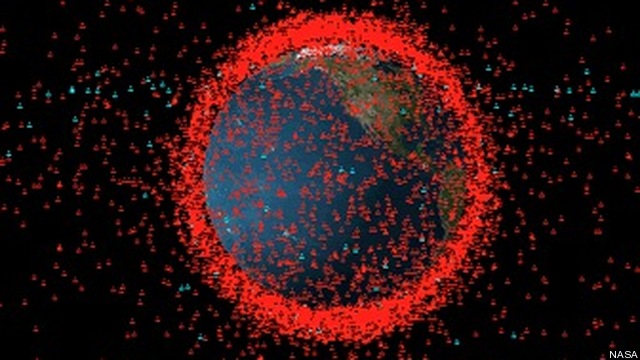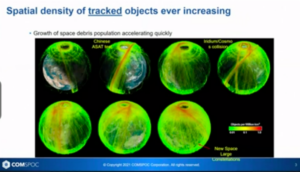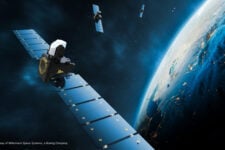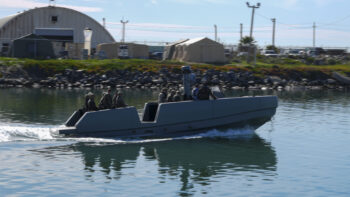
Space debris in orbit around Earth (NASA)
WASHINGTON: The Commerce Department has come under fire from the Senate Commerce, Science & Transportation Committee for foot-dragging on taking over responsibility for warning civil, commercial and foreign satellite operators about potential on-orbit collisions.
In a Thursday hearing, senators expressly raised concerns that Commerce now seems to want to rid itself of the mission entirely — a mission that the Defense Department has been eager to offload, so that its space tracking sensors can be dedicated to watching for threats from adversary space assets.
The Trump administration’s 2018 Space Policy Directive-3 (SPD-3) assigned the Office of Space Commerce (OSC) as the civil agency responsible for space traffic management (STM). That office falls under the National Oceanic and Atmospheric Administration’s National Environmental Satellite, Data and Information Service, which manages US weather satellites; that agency is also the parent body to the Office of Commercial Remote Sensing Regulatory Affairs (CRSRA) that regulates commercial remote sensing satellites.
Under SPD-3, OCS has begun to develop (with the help of DoD) a new, improved space object tracking system called the Open Architecture Data Repository, that unlike DoD’s semi-classified network could widely share data and safety information.

Sen. Cynthia Lummis
“I’m concerned that we’re now three years after SPD-3 was published, and the Commerce Department has been slow to develop the Open Architecture Repository that is desperately needed. Instead, it has commissioned more studies to reexamine the already answered question of which US government agency is best suited to take on the task,” said Sen. Cynthia Lummis, R-Wy., ranking member of the CS&T space and science subcommittee. “I would add that I’m also concerned that the administration has not announced its director to take over the Office of Space Commerce.”
Collision Risks Growing
Lummis stressed the importance and growing urgency of addressing the worsening congestion in space as the number of commercial satellites skyrockets, along with the amount of dangerous space debris.
“I’m so pleased that this is our first hearing topic, it’s timely and important: space traffic management space situational awareness [SSA] and orbital debris. I have no problem being identified as the space junk lady or the trash lady, the space trash lady,” she said.
The expected growth in space junk is of particular concern in Low Earth Orbit, where firms around the world are rushing to launch new mega-constellations of hundreds of satellites to provide Internet services — a capability that DoD itself is extremely interested in.
Paul Graziani, chief executive officer of AGI, provided the senators with a number of graphics showing the recent rapid growth in spacecraft and debris, and the expected explosion of even more junk in the coming years as the population of satellites expands. The increased number of sats, in turn, will result in even more debris being created, he explained.
“Right now we’re on track to have a major collision in Low Earth Orbit roughly every 10 years. And that problem is only getting worse and worse,” he said.
Sen. John Hickenlooper, D-Colo., the subcommittee chair, further stressed the need for the United States to move quickly to establish a STM regime to lay down precedents for responsible behavior that protect US interests on the international stage, given that other countries, including Russia and China, are seeking to set their own rules.
“We need to maintain our leadership in space, every one of you understands that. A big part of this is it must include space traffic management,” he said. The lack of international rules of the road is a serious problem, regulatory regimes demand attention, demand serious attention. The European Union, Russia, China, they’re all developing their own STM frameworks. How we are able to lead on this, and make sure that we set an appropriate framework so that our interests aren’t over overruled, I think is critically important.”

Funding Woes
To be fair, Congress itself had been a sticking point in allowing the Commerce Department to move forward — for several years stalling on providing the necessary funding for it to implement SPD-3. That changed only with the passage of the 2021 omnibus spending package last December, which granted OCS $10 million in funds to kick start a pilot program. That bill also allowed OCS and CRSRA to be merged into one entity, as stipulated in STP-3.
That said, the Biden administration’s fiscal 2022 budget request asked only for $10 million total for the new combined office, with no funds dedicated to setting up the new STM system. A 2020 study by the National Academy of Public Administration (NAPA) commissioned by Congress concurred with Commerce’s estimates at the time that between $57.4 million and $72.4 million would be needed just to buy commercial data and services through 2024.
Asked by Lummis what he thought was holding up the creation of the civil STM system, former OCS head Kevin O’Connell bluntly said a big issue was — and continues to be — a lack of resources.
“It was really was a resource question, the extent to which we had a very, very small budget in the office,” he said. “It’s very much a resource issue, and it needs to be resourced now.”
He further stressed that SPD-3 “recognized the urgency of this problem … given growing security concerns in space, and a parallel growth and commercial space activities,” he said. “A key tenet of SPD-3 was the need to modernize the nation’s SSA architecture, and to leverage commercial capabilities that already exist in the market, communications cloud based data management analytics and other technologies that have helped innovate in many, many other industries can be leveraged here immediately.”
Tom Stroup, head of the Satellite Industry Association (SIA), told the hearing that the commercial space industry needs an STM regime to support its growth and continued innovation.
“Action and funding are needed now,” he said in his written testimony. “The US must act now to implement a modern SSA and STCM environment to support innovation, including leveraging commercial and government capabilities to yield a US developed, cutting-edge space sustainability model. This activity requires adequate funding and staffing.”
Death By Study?
In addition, experts have criticized NOAA’s decision to forgo pursuing commercial capabilities in favor of commissioning yet more studies on the issue. Lawmakers also are questioning why NOAA doesn’t seem to be following Congress’s mandate to purchase commercial data.
“Rather than begin populating an open repository with commercial data, NOAA is using fiscal year 2021 funds to pay for more studies by three federally funded research and development centers, revisiting the topics of the NAPA study, and talking vaguely of a future pilot program,” wrote Scott Pace, former executive secretary of the National Space Council, in an op-ed in Space News.
No Commerce Department officials testified at the hearing. However, in response to questions from Breaking Defense prior to the hearing, a spokesperson insisted that Commerce is “not reprogramming” OCS funds and is complying with the 2021 spending act.
“Consistent with the FY2021 appropriations language, OSC plans to initiate space traffic management pilot activities to improve space situational awareness for commercial space safety. The effort will also conduct analysis, develop technical prototypes, and perform demonstrations,” the spokesperson wrote. “The NAPA study indicated which agency was best suited to perform national civil STM tasks. Further efforts in FY2021 will be used to refine the specific features of an optimal space traffic model.”
FY25 out-year budget plans can’t support Space Force ambitions: Experts
“The Space Force is not growing in priority as it had been in previous years. The priority is shifting more towards the the Air Force and the Navy in the budget,” said Todd Harrison, senior fellow at the American Enterprise Institute.



























